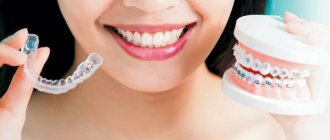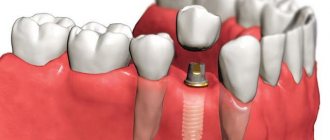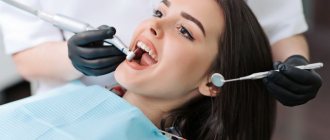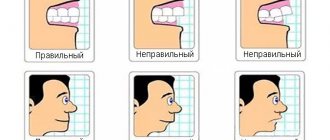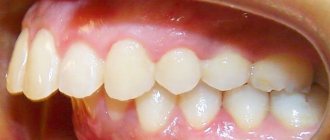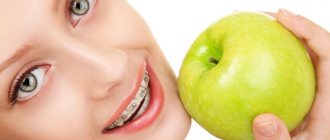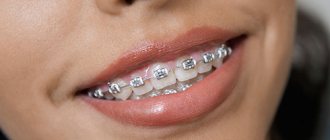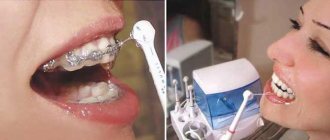2047
The desire to have an attractive smile and straight teeth are the main incentives for orthodontic treatment for most patients.
Having achieved a positive result from wearing braces, a person begins to be proud of his appearance, since always with the correction of the bite, a change in the shape and relationship of the parts of the face occurs in parallel.
The relationship between bite and appearance
It has long been proven that the appearance and contours of the face depend on the location and construction of the skull bones, the correct relationship of the jaw arches and their parameters. Therefore, any, even minor, malocclusion defects, having a negative impact on appearance, provoke the occurrence of the following aesthetic problems:
- too thin lips:
- massive chin;
- facial distortion;
- depression of the cheeks.
In addition, improper connection of the jaw arches causes the early appearance of signs of aging, especially wrinkles.
In dentistry, several types of atypical bite have been identified, and each gives rise to certain changes in the appearance of its owner.
Mesial
The main feature is a massive chin. With this variety, the lower jaw protrudes far forward relative to the upper jaw, which is why the lower jaw arch and the chin itself visually look larger than their actual size.
This jaw ratio increases the load on the temporal joints and creates tension in the neck muscles. As a result, the facial expression appears offended, sullen, or dramatic to others.
A concave or flat profile is formed, the lower lip protrudes relative to the lower lip. A woman with a similar bite will have an overly masculine face.
Distal
The defect in question is characterized by insufficient development of the mandibular arch or, on the contrary, excessive growth of the upper one. From the side it is expressed in the protrusion of the upper frontal teeth relative to the lower ones.
From here, the chin looks unnaturally small, sloping, the upper lip protrudes, and the nose seems protruding. A “double chin”, a supramental fold, quickly appears.
People with a distal bite, regardless of the feelings they experience, have an astonished or indecisive appearance, the corners of the lips are always ugly downward.
Let's find out together what you can't eat with braces on your teeth and why you need to follow a diet.
Check here to find out how long pain lasts after braces.
At this address https://zubovv.ru/ortodontiya/breketyi/osnovyi-uhoda-v-period-lecheniya.html we will tell you how to properly care for teeth with braces.
Deep
A specific feature is that the maxillary incisors overlap similar units of the lower jaw by more than ½ (the norm is one third).
A similar defect may also affect the side elements. The consequence is a visually distorted face shape, i.e. it looks flattened from below, while the lower lip seems to “turn” outward.
If, with such signs, a person’s forehead is low, the face seems very tiny in relation to the proportions of the whole body.
Often, such changes lead to the development of the habit of always pursing the lips, which is why they look very miniature, further reducing the size of the face.
Cross
This abnormal condition may result from improper development of one of the jaws. The defect can be unilateral or bilateral, and can occur in the anterior or lateral area of the dentition.
It is recognized by the violation of the overlap of the maxillary units with the mandibular elements, which leads to asymmetry of the facial contours.
Open
It manifests itself in the absence of connection of the lateral units or the anterior section, which is why a gap appears between the rows - an interrow gap.
When a gap appears in the frontal region, the mouth is slightly open. In addition, the shape of the face becomes elongated, and the expression seems stupid.
If a gap (or gaps) appears in the lateral region, then the symmetry of the face is disturbed, a “sinking” of the cheeks appears, similar to a hollow, with a complete absence of dental elements. To all this is added a surprised or confused expression on the face, which does not color the person at all.
Improper jaw closure is a fairly common problem in dentistry. In addition to physiological discomfort and health problems, the defect entails the development of a psychological complex associated with dissatisfaction with one’s appearance.
The level of development of modern orthodontics makes it possible to eliminate any bite pathology, and thereby improve appearance without plastic surgery.
Nose
In patients with a reduced distance between the nose and upper lip and teeth protruding forward, the tip of the nose often noticeably drops down, giving the face a dull appearance, and the lip, on the contrary, protrudes upward. This occurs due to excessive tension in the muscles of the upper lip, which drags the skin along with it. Rhinoplasty is not needed in this case. After treatment with braces, the nose will rise slightly upward, and its owner will probably begin to receive compliments regarding her changed appearance.
Impact of systems
Many patients draw a parallel between the work of two specialists - an orthodontist and a plastic surgeon. Naturally, there is some truth in such a comparison. Although it is impossible to change your face beyond recognition with braces, you can expect significant improvements in appearance upon completion of orthodontic treatment.
The action of bite-correcting structures always goes in one direction - the teeth are placed in the desired position, the dentition is aligned, the relative position of the jaw arches, and sometimes the skull bones, changes. The result of this treatment is a beautiful smile and attractive appearance.
Patients, having undergone bite correction with orthodontic devices, note the following changes in their appearance:
- Face . The oval and ratio of the parts of the face do not always change. The likelihood of change depends on the degree of occlusion, the age of the person and the individual characteristics of the body.
- Cheeks. More often they become sunken (like a thin person). There are explanations for this fact.
Firstly, almost always before positioning the braces, the third molars (these are the outermost units in the dentition) are removed, due to the relief of the jaw arches.Secondly, changes occur in the diet of people wearing the systems: there is more liquid and healthy food, which is why the patient simply loses weight. A decrease in his body weight leads to “thinner” cheeks.
- Chin. Changes in its parameters depend on the initial severity of the pathology. If the chin comes forward too much, it goes back. It was beveled - it moves forward. When there are minor problems with the bite, the changes do not affect the chin.
- Lips. They acquire additional volume in the literal sense, since they now have braces underneath them. After removing the device, this effect will disappear.
- Cheekbones. Gain expressiveness. If before treatment a person, trying to smile, closed his lips to hide uneven teeth, then after treatment, other muscle groups begin to work, emphasizing the attractiveness of the smile.
Such changes occur against the background of a restructuring of the maxillofacial apparatus - an even redistribution of the load on the muscular system and bones helps eliminate external facial defects caused by improper occlusion.
results
Braces help the patient achieve a straight and beautiful smile. Crooked teeth are straightened, malocclusion is corrected. This is clearly visible even in photographs, if you compare pictures before and after treatment.
In addition, the device solves some other problems. It promotes:
- Restoring chewing function.
- Normalization of the temporomandibular joints.
- Changes in facial features. They become more correct.
Negative phenomena
The process of correcting malocclusion with braces is always accompanied by discomfort, some pain and other unpleasant symptoms.
The manifestation is considered normal by orthodontists, and is a consequence of the influence of the corrective design on the dental system.
Before installing braces, a specialist must objectively assess the likelihood of treatment risks, weighing the likely damage and benefits.
This is especially important for people who are prone to periodontal tissue diseases, thinning and abrasion of the enamel coating, gingivitis, and stomatitis.
Adaptation period
Negative symptoms in the form of pain and discomfort immediately after positioning the corrective structure are inevitable, since the force arc begins to exert pressure on all dental elements.
In addition, it is very difficult for the body to get used to the presence of a foreign body in it.
The average duration of the adaptation period is no more than 3 weeks. At this time, in addition to pain and discomfort, the following phenomena are noted:
- irritation and even inflammation of the gums due to increased pressure and contact of gum tissue with structural parts;
- pain in the head due to increased load on the bones of the face and skull;
- slurred speech due to poor pronunciation;
- excessive salivation (especially if a lingual type system is installed);
- inconvenience when eating;
- mandatory dietary adjustments to reduce the likelihood of device failure and locks coming unstuck;
- complicating the implementation of everyday oral hygiene , which requires a lot of time.
All of these manifestations disappear on their own, or the patient adapts to them and gets used to having braces in the mouth.
To reduce the severity of pain, doctors prescribe painkillers in a dosage appropriate for the individual patient. In addition, to protect the mucous membrane from rubbing, it is recommended to apply orthodontic wax to the protruding parts of the device.
Which braces are better - aesthetic or metal and what determines the choice.
In this publication, read whether it is possible to get braces under the compulsory medical insurance policy.
Here we will tell you whether you can get a tax deduction for braces.
Main period
The patient will experience manifestations of toothache of varying degrees of intensity throughout the entire course of treatment. Its highest peak occurs on days in which the arch is tightened or adjusted.
In addition to pain, common symptoms of the main period of wearing braces are:
- Rubbing the mucous membrane . This phenomenon is characterized by smaller affected areas and faster healing. So, rubbing can occur as a result of a long conversation, and disappear literally the next day.
- Slight mobility of dental units . This is explained by the fact that the connective ligaments that secure the teeth in the bone stretch slightly after installation of the corrective apparatus, resulting in slight mobility. This symptom will disappear a couple of weeks after the structure is removed.
- Sensation of teeth moving . This is normal, because the dental elements actually move to the desired position under the influence of the device.
- Unnatural smile . Despite the fact that modern devices have minimal parameters, their owners are embarrassed to smile and hide the presence of the device behind their lips. As a result, the smile comes out unaesthetic and unnatural.
- Carious lesions and damage to the enamel coating .
Inadequate hygiene, due to the complexity of its implementation, becomes the reason for the formation and accumulation of plaque, which over time becomes the cause of caries. Because of this, dentists insist on the need for professional cleanings and examinations during orthodontic treatment. - Destruction of the upper zone of dental roots . The reason for this condition is strong pressure, the effect of which is aimed at displacing crooked teeth. This is mainly experienced by patients with short or rounded dental elements. Therefore every 6 months. It is recommended to undergo radiography in order to detect the problem early.
- Allergy . Despite the fact that most design models are made from hypoallergenic materials, the likelihood of developing allergies is still present. After installing the device, it is important to monitor your health and consult a doctor at the first atypical reactions.
- Difficulties in performing hygiene procedures .
Due to the frequent stuckness of food particles between the parts of the device and the enamel, patients need to clean their mouth more thoroughly after each snack. When it is not possible to brush your teeth, dentists recommend thoroughly rinsing your mouth with plain water.
The final stage
After the treatment is completed and the braces are removed, patients believe that all the troubles are behind them. But here other problems arise:
- Stains on the enamel coating . After peeling off the plates, stains are clearly visible on the teeth. This effect became obvious due to insufficient oral care during correction, as well as due to the specificity of the device itself. Enamel pigmentation is very difficult to prevent.
- Changing face. Removing braces visually changes the face - it becomes oval and more elongated, the formation of nasolabial folds is noted, and the cheeks recede.
- Demineralization of enamel. The impact of the structure often leads to changes in the structure and quality of the enamel coating: it becomes sensitive and thins. For this reason, doctors advise periodically using fluoride-containing rinses and coming to the clinic for preventive examinations.
- Moving teeth to their original location. Despite the length of time you wear braces, your teeth tend to return to their previous position after they are removed. This phenomenon occurs when retainers are abandoned or certain anatomical features of the dental system.
- Destruction of enamel. It occurs both as a result of long-term wearing of a corrective device, and because of the individual characteristics of the body: reduced immunity, natural weakness of enamel, health problems.
- Dental diseases. The development of inflammation of gum tissue, caries and other pathologies are a consequence of poor hygiene.
Important! The occurrence of negative reactions, pathologies or pain is a reason to contact your doctor. Well-chosen treatment and recommendations will help you feel better or stop pathological changes.
The video provides an example of the behavior of braces treatment and the result of changes.
Braces - what are they?
Braces are a non-removable dental device for straightening canines and other teeth in adults and children. Depending on the characteristics of the curvature, the device can be attached both to the outside and to the inside of the dentition. Briquettes are special in that each of them seems to direct the tooth in the required direction, which is prescribed in its program. The design of braces also includes an arch, characterized as orthodontic. This arc can be bent as you like, however, it will always return to its original position.
Additional parts can also act on the teeth in this system, among which are iron springs and orthodontic-type rings. Sometimes, to carry briquettes, the fours are removed. The changes in the face after wearing braces are obvious, and the result can be clearly seen in the photo.
Useful tips
Prevention, including the following actions, will help to avoid unpleasant phenomena and complications:
- Choose an experienced, highly qualified doctor . The success of treatment, which must be properly planned, and the corrective device correctly selected and installed, directly depends on the skillful actions of a specialist.
- Eliminate dental disease before placing braces. To preserve teeth and prevent the occurrence of oral pathologies, it is important to cure caries, perform professional cleaning, replace fillings, and coat the enamel with special strengthening compounds.
- Maintain good hygiene. The importance of cleansing the oral cavity has already been discussed. It is necessary to supplement daily care with the use of an irrigator, floss, and a dental brush. Brushing your teeth should last longer, all actions should be careful.
- Visit the orthodontist according to your schedule .
Scheduled visits are necessary to monitor the correct progress of treatment, adjust the position and tension of the arch, replace ligatures, adjust traction and springs, and assess the quality of plate fastening. The frequency of visits is determined by the doctor individually, and depends mostly on the complexity of the defect and the model of the device. - Eat properly. To preserve the enamel coating and prevent dental diseases, you need to adhere to a diet, namely, limit the consumption of sugar, carbonated drinks, solid foods, and diversify the menu with foods high in vitamins and individual microelements (fluorine, magnesium, calcium, phosphorus).
- Wear retainers for a period determined by the orthodontist . To consolidate and maintain the result of the correction, it is necessary to use retainers. It is unacceptable to ignore or violate the timing of the retention period.
Photos of patients
Reviews
Changing your bite is a long and hard job. A person has to face a lot of difficulties throughout the entire treatment course.
Here it is important to prepare yourself psychologically and be prepared for the fact that a complex orthodontic apparatus will appear on your teeth. It will not only require changing habits and a special attitude towards hygiene, but will also change your appearance.
If you have had to undergo orthodontic treatment and would like to share your opinion regarding the problems discussed, please leave a comment on this article.
If you find an error, please select a piece of text and press Ctrl+Enter.
Tags braces
Did you like the article? stay tuned
When are braces indicated?
Adults with bite problems may benefit from seeking orthodontics to correct them. We are talking about the following indications:
- aesthetic dental defects,
- noticeable deficiencies in the closure of the jaws (for example, the fangs have moved forward),
- incorrect facial proportions,
- deep bite,
- crossbite,
- pain when eating.
Before installing braces, the patient undergoes a full examination for the best result. It often happens that the body accepts the system as a foreign body. That is why it is important not only to prepare for the installation of briquettes, but also to correct all dental problems.

